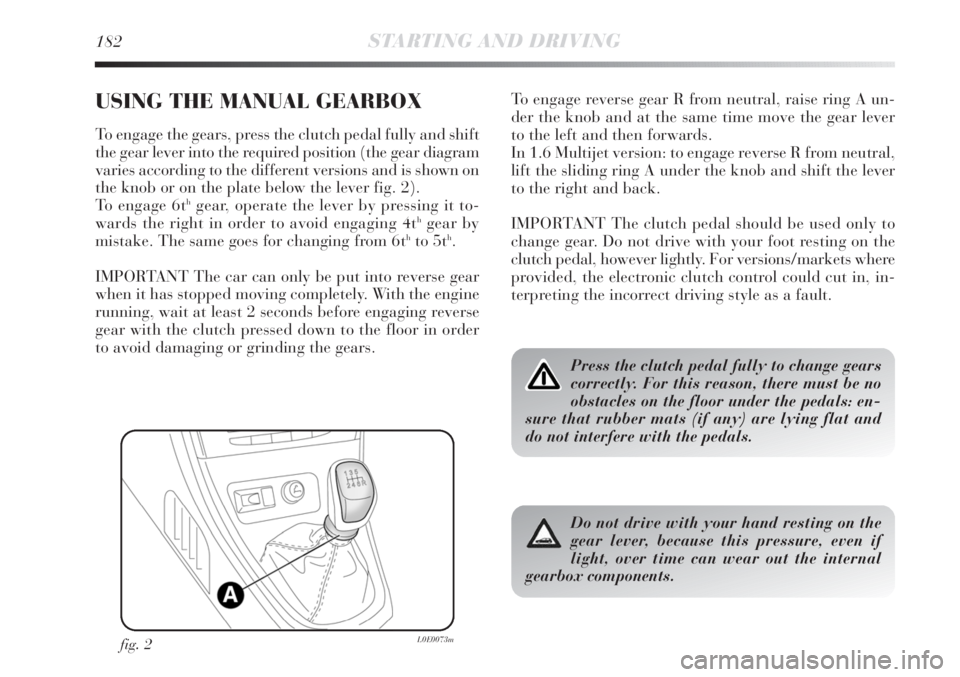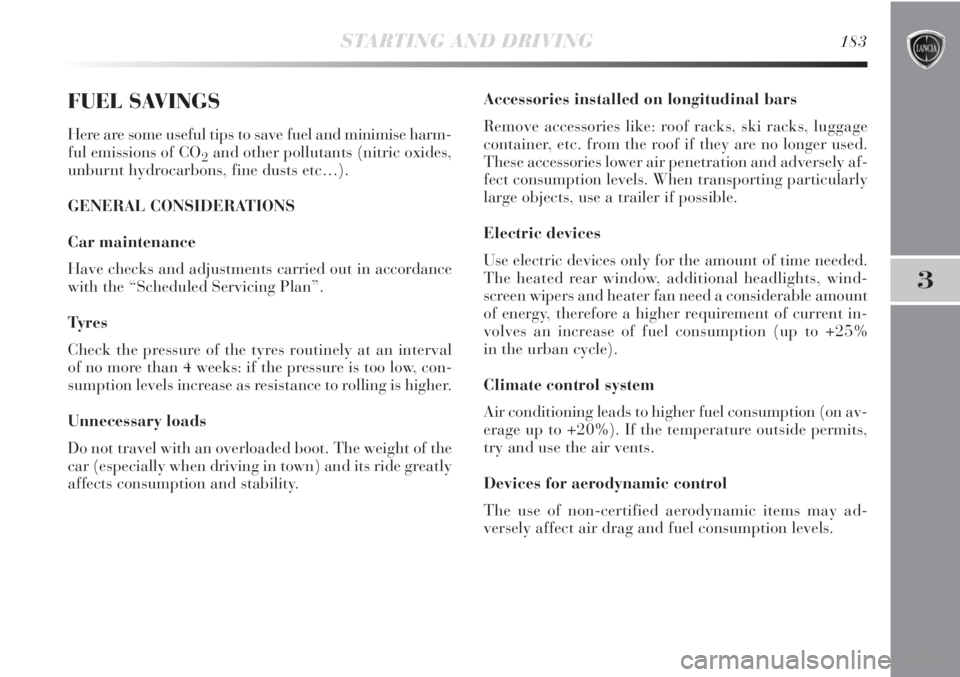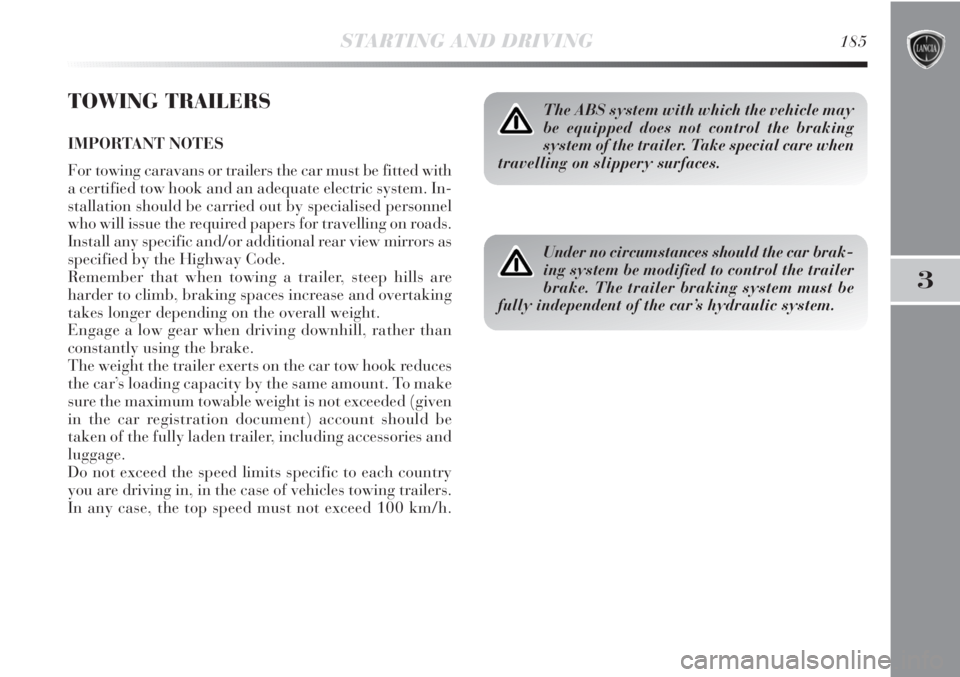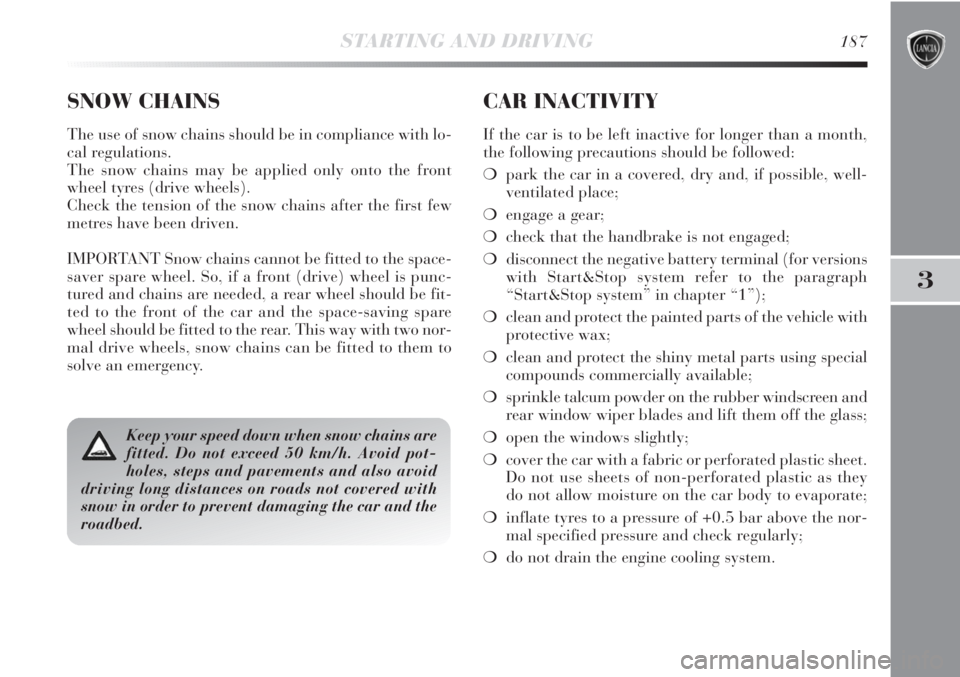Lancia Delta 2013 Owner handbook (in English)
Manufacturer: LANCIA, Model Year: 2013, Model line: Delta, Model: Lancia Delta 2013Pages: 295, PDF Size: 8.29 MB
Page 181 of 295

3
STARTING AND DRIVING179
If the engine does not start at the first attempt, return the
ignition key to STOP before repeating the procedure.
If, when the ignition key is turned to MAR, the instru-
ment panel warning light
Yremains on together with
warning light U, turn the key to STOP and then back to
MAR; if the warning light remains on, try the other keys
provided with the vehicle.
Contact a Lancia Dealership if you still cannot start the
engine.
STARTING PROCEDURE FOR DIESEL VERSIONS
Proceed as follows:
❍engage the handbrake;
❍put the gear lever into neutral;
❍turn the ignition key to MAR: the warning lights
mandYon the instrument panel will turn on;
❍wait for the warning lights
Yandmto turn off.
The hotter the engine is, the quicker this will happen;
❍fully depress the clutch pedal without operating the
accelerator;
❍turn the ignition key to AVV as soon as warning light
mgoes out. Waiting too long will waste the work
done by the glow plugs.
Release the key as soon as the engine starts.IMPORTANT With the engine cold, the accelerator pedal
must be fully released when you turn the ignition key to
AV V.
If the engine does not start at the first attempt, return the
ignition key to STOP before repeating the procedure. If
instrument panel warning light
Yremains lit when the
ignition key is turned to MAR, turn the key to STOP and
then back to MAR; if the warning light remains lit, try the
other keys provided with the vehicle. Contact a Lancia
Dealership if you still cannot start the engine.
Warning light mwill flash for 60 seconds
after starting or during prolonged cranking
to indicate a fault with the glow plug heat-
ing system. You can use the car as usual if the en-
gine starts but you should contact a Lancia Deal-
ership as soon as possible.
Page 182 of 295

180STARTING AND DRIVING
Never bump start the engine by pushing,
towing or coasting downhill. This could
cause a flow of fuel into the catalytic con-
verter and damage it beyond repair.
HOW TO WARM UP THE ENGINE
AFTER IT HAS JUST STARTED
Proceed as follows:
❍drive off slowly, letting the engine turn at medium
speed. Do not accelerate abruptly;
❍do not demand maximum performance for the first
few kilometres. Wait until the engine coolant gauge
starts moving.STOPPING THE ENGINE
Turn the ignition key to STOP while the engine is idling.
IMPORTANT After a taxing drive, you should allow the
engine to “catch its breath” before turning it off by let-
ting it idle to allow the temperature in the engine com-
partment to fall.
A quick burst on the accelerator before turn-
ing off the engine serves absolutely no prac-
tical purpose, it wastes fuel and is damag-
ing especially to turbocharged engines.
Page 183 of 295

3
STARTING AND DRIVING181
HANDBRAKE
The handbrake lever is located between the two front
seats.
Pull the lever upwards to operate the handbrake, until
the vehicle is braked.
The car should be braked after a few clicks
of the lever; if it is not, contact a Lancia
Dealership to have it adjusted.
When the handbrake is on and the ignition key is at MAR,
the instrument panel warning light xwill come on.
Proceed as follows to release the handbrake:
❍slightly lift the handbrake and press release button
A-fig. 1;
❍keep button A pressed and lower the lever. The warn-
ing light xon the instrument panel will turn off.
Press the brake pedal when carrying out this operation
to prevent the car from moving accidentally. PARKING THE VEHICLE
Proceed as follows:
❍stop the engine and engage the handbrake;
❍engage a gear (on a slope, engage first gear if the car
is facing uphill or reverse if it is facing downhill) and
leave the wheels steered.
If the car is parked on a steep slope, it is also advisable
to block the wheels with a wedge or stone.
Do not leave the ignition key turned to MAR to prevent
draining the battery. Always remove the key when you
leave the car.
Never leave children in the unattended car. Always re-
move the ignition key when leaving the car and take it
out with you.
fig. 1L0E0072m
Page 184 of 295

182STARTING AND DRIVING
USING THE MANUAL GEARBOX
To engage the gears, press the clutch pedal fully and shift
the gear lever into the required position (the gear diagram
varies according to the different versions and is shown on
the knob or on the plate below the lever fig. 2).
To engage 6t
hgear, operate the lever by pressing it to-
wards the right in order to avoid engaging 4thgear by
mistake. The same goes for changing from 6thto 5th.
IMPORTANT The car can only be put into reverse gear
when it has stopped moving completely. With the engine
running, wait at least 2 seconds before engaging reverse
gear with the clutch pressed down to the floor in order
to avoid damaging or grinding the gears.
fig. 2L0E0073m
To engage reverse gear R from neutral, raise ring A un-
der the knob and at the same time move the gear lever
to the left and then forwards.
In 1.6 Multijet version: to engage reverse R from neutral,
lift the sliding ring A under the knob and shift the lever
to the right and back.
IMPORTANT The clutch pedal should be used only to
change gear. Do not drive with your foot resting on the
clutch pedal, however lightly. For versions/markets where
provided, the electronic clutch control could cut in, in-
terpreting the incorrect driving style as a fault.
Press the clutch pedal fully to change gears
correctly. For this reason, there must be no
obstacles on the floor under the pedals: en-
sure that rubber mats (if any) are lying flat and
do not interfere with the pedals.
Do not drive with your hand resting on the
gear lever, because this pressure, even if
light, over time can wear out the internal
gearbox components.
Page 185 of 295

3
STARTING AND DRIVING183
FUEL SAVINGS
Here are some useful tips to save fuel and minimise harm-
ful emissions of CO
2and other pollutants (nitric oxides,
unburnt hydrocarbons, fine dusts etc…).
GENERAL CONSIDERATIONS
Car maintenance
Have checks and adjustments carried out in accordance
with the “Scheduled Servicing Plan”.
Ty r e s
Check the pressure of the tyres routinely at an interval
of no more than 4 weeks: if the pressure is too low, con-
sumption levels increase as resistance to rolling is higher.
Unnecessary loads
Do not travel with an overloaded boot. The weight of the
car (especially when driving in town) and its ride greatly
affects consumption and stability.Accessories installed on longitudinal bars
Remove accessories like: roof racks, ski racks, luggage
container, etc. from the roof if they are no longer used.
These accessories lower air penetration and adversely af-
fect consumption levels. When transporting particularly
large objects, use a trailer if possible.
Electric devices
Use electric devices only for the amount of time needed.
The heated rear window, additional headlights, wind-
screen wipers and heater fan need a considerable amount
of energy, therefore a higher requirement of current in-
volves an increase of fuel consumption (up to +25%
in the urban cycle).
Climate control system
Air conditioning leads to higher fuel consumption (on av-
erage up to +20%). If the temperature outside permits,
try and use the air vents.
Devices for aerodynamic control
The use of non-certified aerodynamic items may ad-
versely affect air drag and fuel consumption levels.
Page 186 of 295

184STARTING AND DRIVING
DRIVING STYLE
Starting
Do not warm the engine with the car at a standstill or at
idle or high speed: under these conditions the engine
warms up much more slowly, increasing electrical con-
sumption and emissions. It is therefore advisable to move
off immediately, slowly, avoiding high speeds: in this way
the engine will warm faster.
Unnecessary actions
Avoid revving up when at traffic lights or before stopping
the engine. The latter action, like double-declutching, is
completely unnecessary and causes increased fuel con-
sumption and pollution.
Gear selection
As soon as the conditions of the traffic and road allow,
use a higher gear. Using a low gear for faster acceleration
will increase consumption.
In the same way improper use of a high gear increases
consumption, emissions and engine wear.
Max. speed
Fuel consumption considerably increases with speed.
Avoiding unnecessary braking and acceleration, which
cost in terms of both fuel and emissions.Acceleration
Accelerating violently will greatly affect consumption and
emissions: acceleration should be gradual.
CONDITIONS OF USE
Cold starting
Short journeys and frequent cold starts do not allow the
engine to reach optimum operating temperature. This re-
sults in a significant increase in consumption levels (from
+15 to +30% on the urban cycle) and emissions.
Traffic and road conditions
Rather high fuel consumption is caused by heavy traf-
fic, for instance when travelling in a queue with frequent
use of low gears or in large towns with many traffic lights.
Mountain and rough roads also have a negative effect on
fuel consumption.
Traffic hold-ups
During prolonged hold-ups (e.g. level crossings) the en-
gine should be switched off.
Page 187 of 295

3
STARTING AND DRIVING185
TOWING TRAILERS
IMPORTANT NOTES
For towing caravans or trailers the car must be fitted with
a certified tow hook and an adequate electric system. In-
stallation should be carried out by specialised personnel
who will issue the required papers for travelling on roads.
Install any specific and/or additional rear view mirrors as
specified by the Highway Code.
Remember that when towing a trailer, steep hills are
harder to climb, braking spaces increase and overtaking
takes longer depending on the overall weight.
Engage a low gear when driving downhill, rather than
constantly using the brake.
The weight the trailer exerts on the car tow hook reduces
the car’s loading capacity by the same amount. To make
sure the maximum towable weight is not exceeded (given
in the car registration document) account should be
taken of the fully laden trailer, including accessories and
luggage.
Do not exceed the speed limits specific to each country
you are driving in, in the case of vehicles towing trailers.
In any case, the top speed must not exceed 100 km/h.
The ABS system with which the vehicle may
be equipped does not control the braking
system of the trailer. Take special care when
travelling on slippery surfaces.
Under no circumstances should the car brak-
ing system be modified to control the trailer
brake. The trailer braking system must be
fully independent of the car’s hydraulic system.
Page 188 of 295

186STARTING AND DRIVING
IMPORTANT When snow tyres are used with a maxi-
mum speed index below the one that can be reached by
the car (increased by 5%), place a notice in the passen-
ger compartment, plainly in view, which states the max-
imum permissible speed of the snow tyres (as per an EC
Directive).
All four tyres should be the same (brand and track) to en-
sure greater safety when driving and braking and better
driveability.
Remember that it is inappropriate to change the rotation
direction of tyres.
The max. speed of snow tyres with “Q”
marking is 160 km/h. The Highway Code
speed limits must however be always com-
plied with.
SNOW TYRES
Use snow tyres of the same size as the normal tyres pro-
vided with the car.
A Lancia Dealership will be happy to provide advice con-
cerning the most suitable type of tyre for your require-
ments.
For the type of snow tyre to fit, the inflation pressures and
specifications, follow the instructions in the “Wheels”
paragraph in chapter “6” very carefully. The winter fea-
tures of these tyres are reduced considerably when the
tread depth is below 4 mm. Replace them in this case.
Due to snow tyre features, under normal conditions of use
or on long motorway journeys, the performance of these
tyres is much lower than that of standard tyres. Their us-
age should therefore be restricted in accordance with to
their type approval.
Page 189 of 295

3
STARTING AND DRIVING187
Keep your speed down when snow chains are
fitted. Do not exceed 50 km/h. Avoid pot-
holes, steps and pavements and also avoid
driving long distances on roads not covered with
snow in order to prevent damaging the car and the
roadbed.
SNOW CHAINS
The use of snow chains should be in compliance with lo-
cal regulations.
The snow chains may be applied only onto the front
wheel tyres (drive wheels).
Check the tension of the snow chains after the first few
metres have been driven.
IMPORTANT Snow chains cannot be fitted to the space-
saver spare wheel. So, if a front (drive) wheel is punc-
tured and chains are needed, a rear wheel should be fit-
ted to the front of the car and the space-saving spare
wheel should be fitted to the rear. This way with two nor-
mal drive wheels, snow chains can be fitted to them to
solve an emergency.
CAR INACTIVITY
If the car is to be left inactive for longer than a month,
the following precautions should be followed:
❍park the car in a covered, dry and, if possible, well-
ventilated place;
❍engage a gear;
❍check that the handbrake is not engaged;
❍disconnect the negative battery terminal (for versions
with Start&Stop system refer to the paragraph
“Start&Stop system” in chapter “1”);
❍clean and protect the painted parts of the vehicle with
protective wax;
❍clean and protect the shiny metal parts using special
compounds commercially available;
❍sprinkle talcum powder on the rubber windscreen and
rear window wiper blades and lift them off the glass;
❍open the windows slightly;
❍cover the car with a fabric or perforated plastic sheet.
Do not use sheets of non-perforated plastic as they
do not allow moisture on the car body to evaporate;
❍inflate tyres to a pressure of +0.5 bar above the nor-
mal specified pressure and check regularly;
❍do not drain the engine cooling system.
Page 190 of 295

188STARTING AND DRIVING
page intentionally left blank